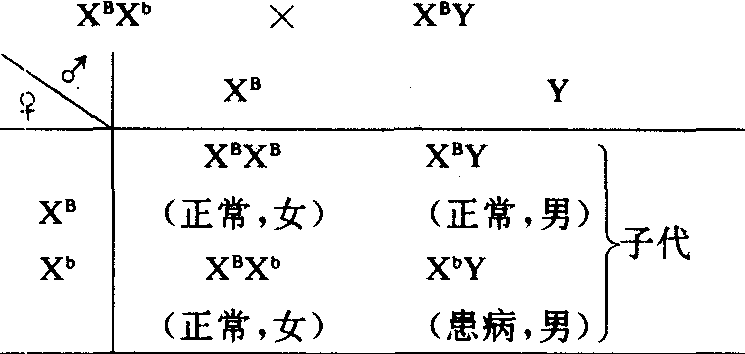血友病xueyou bing
以凝血机制发生障碍为主要特征的出血性遗传疾病。一般说的血友病,指的是甲型血友病。患者血浆中缺少一种凝血物质——抗血友病球蛋白。因此,纵使轻微碰伤,也可能引起大出血而死亡。血友病属X隐性遗传病(参见“X隐性伴性遗传”条)。令一女子的基因型为XBXb,一男子的基因型为XBY,其中XB和Xb分别代表X染色体上存在正常基因B和致病基因b。他们结婚后子代的表现为:
血友病患者几乎全是男性。这一方面是因为,和红绿色盲(参见“色盲症”条)一样,它也是由X隐性遗传决定的;另一方面是因为该病病情严重,几乎不可能使女性患者活到生育年龄(很难通过月经期这一关),因此,人群中女性基因型几乎全是XBXB和XBXb,表现正常。

血友病xueyoubing
由于先天性凝血障碍造成出血性疾病。根据凝血因子缺乏的种类和程度不同分为血友病A、B、C三种,以血友病A常见。遗传方式为X伴性隐性遗传。女性患病罕见。带血友病基因的女性携带者,将此病传给下一代的男性。患病者约80%有家族史。症状:发病年龄多在婴幼儿时期。主要表现为出血倾向。患儿在未发生出血时,与正常小儿无异,但轻微外伤即能引起长期甚至致命的出血,多为皮下、肌肉及关节出血。
❶皮肤出血为瘀斑、血肿,较久变为棕黄色,局部稍硬。原有出血正在吸收,新的出血又可发生。血肿过大,可产生不同的压迫症状。粘膜出血常见于口腔、牙龈、唇舌或鼻部。出牙换牙及轻微舌咬伤均可渗血不止。
❷关节出血常发生在膝、踝、肩、肘等部位。急性期关节肿胀和痛疼,多次出血吸收不完全,关节可发生慢性炎症,局部活动受限。
❸内脏也可出血,胃肠出血致腹痛,腹胀,吐血或便血。
❹尿血也很常见。血友病A比血友时病B出血重,血友病C出血症状更轻,自发出血较少,多在拔牙、扁桃体摘除术后出血不止。治疗:
❶预防出血:减少剧烈活动,避免外伤。
❷输血或血浆补充凝血因子。
❸对症治疗:对急性关节出血,原则上是止血、止痛、恢复关节运动功能,早期局部冷敷,加压包扎。
❹药物治疗:肾上腺皮质激素可减轻关节炎症,促进吸收。贫血患儿可给铁剂治疗。止血药6-氨基己酸、血宁片 (花生米衣)等可有止血作用。
血友病
是一组遗传性凝血障碍所致的出血性疾病。包括1.血友病A,缺乏凝血因子Ⅷ即抗血友病球蛋白(AHG)。2血友病B,缺乏凝血因子Ⅸ即血浆凝血活酶成分(PTC)。3.血友病C,缺乏凝血因子Ⅺ即血浆凝血活酶前质(PTA)。血友病A最常见。自发或轻微损伤后出血不止是本病的特点。出血见于皮下、粘膜、肌肉、内脏、关节。可形成瘀斑、青块或血肿。治疗措施为预防出血、补充凝血因子、局部止血和药物治疗。
血友病hemophilia
一种先天性出血性疾病。由性联锁隐性基因遗传,以血液凝固障碍为特征。主要与凝固因子缺乏有关。凝血因子Ⅷ称为血友病A,凝固因子Ⅸ称为血友病B。血友病具有特殊的隐性伴性性遗传规律,为X-连锁基因型,雌性杂合体仅为隐性基因携带者,本身不表现临床症状。隐性基因携带雌畜与显性雄畜产生的后代中,雌雄各有50%发病,其余的雌性为隐性基因携带者,雄性正常。动物中见于马、犬和猫。由于血液不易凝固,症状表现为内出血,皮下血肿,开放性创伤的出血不止,但血小板数正常,血液有形成分也无变化,严重失血可引起死亡,因该病具有遗传性,故发现后不论公母畜,都不作种用。对病畜作局部止血和全身输血疗法。但维生素K3及钙剂治疗无效。